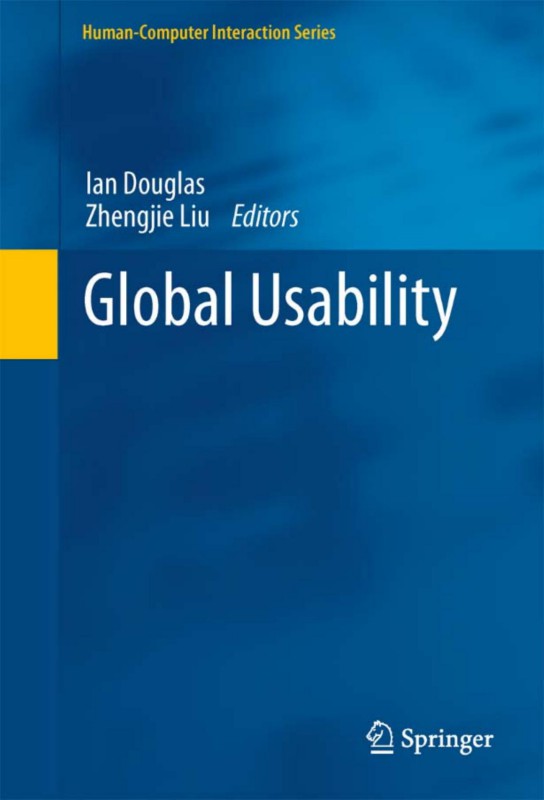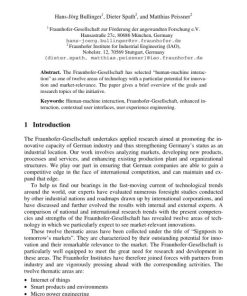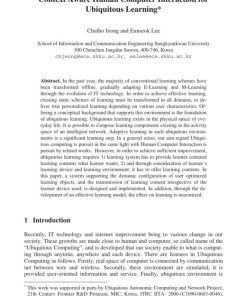Global Usability Human Computer Interaction Series 1st Edition by Ian Douglas, Zhengjie Liu ISBN 0857293044 9780857293046
$50.00 Original price was: $50.00.$25.00Current price is: $25.00.
Authors:Ian Douglas, Zhengjie Liu , Tags:Springer 2011; 0857293036 9780857293039 , Author sort:Ian Douglas, Zhengjie Liu , Languages:Languages:eng
Global Usability Human Computer Interaction Series 1st Edition by Ian Douglas, Zhengjie Liu – Ebook PDF Instant Download/Delivery. 0857293044, 9780857293046
Full download Global Usability Human Computer Interaction Series 1st Edition after payment

Product details:
ISBN 10: 0857293044
ISBN 13: 9780857293046
Author: Ian Douglas, Zhengjie Liu
The concept of usability has become an increasingly important consideration in the design of all kinds of technology. As more products are aimed at global markets and developed through internationally distributed teams, usability design needs to be addressed in global terms. Interest in usability as a design issue and specialist area of research and education has developed steadily in North America and Europe since the 1980’s. However, it is only over the last ten years that it has emerged as a global concern. Global Usability provides an introduction to the important issues in globalizing design and an insight into the development of usability expertise around the world. The book is divided into two sections. The first section deals with the general issues in cross-cultural design and the methods for conducting usability design and evaluation across geographical boundaries. The second section describes the state of usability development in fifteen countries. The descriptions include a history and review of activities and include some unique perspectives that have developed in relation to usability work. Researchers and practitioners from a variety of design-related disciplines will find the book a useful guide for understanding the issues and an excellent reference source for working in any of the countries covered.
Global Usability Human Computer Interaction Series 1st Table of contents:
Part I: Foundations of Global Usability
-
Understanding Usability in a Global Context
- Definition of usability and its significance in user-centered design.
- Challenges and opportunities in designing for global audiences.
- Cultural and linguistic factors that affect usability.
-
Cultural Dimensions of Human-Computer Interaction
- Overview of cultural dimensions (e.g., Hofstede’s cultural dimensions theory).
- How cultural differences influence user expectations and interactions with technology.
- Designing for diverse cultural contexts: an introduction to cross-cultural usability.
-
Theories and Models in Human-Computer Interaction
- Key theories in HCI and their relevance to global usability.
- Models for understanding user behavior across different cultures.
- Cognitive processes, emotions, and cultural variations in interface design.
Part II: Designing for Global Audiences
-
Internationalization and Localization in HCI
- Differences between internationalization and localization in interface design.
- Best practices for adapting software for global markets.
- Issues with language translation, symbols, and local conventions.
-
Designing Culturally Sensitive User Interfaces
- Understanding cultural preferences in color, layout, icons, and symbols.
- Designing for different writing systems, including right-to-left and top-to-bottom scripts.
- Sensitivity to local customs, beliefs, and values in design.
-
Language and Communication in Global Usability
- Addressing language barriers in UI/UX design.
- The role of language in international communication and interaction design.
- Designing for multilingual interfaces and handling diverse language needs.
Part III: Usability Testing and Evaluation in a Global Context
-
Usability Testing Methods for Global Audiences
- Techniques for testing usability across different cultures.
- How cultural differences impact the interpretation of test results.
- Practical approaches to remote and cross-cultural usability testing.
-
Cultural Differences in User Expectations and Behavior
- Identifying and analyzing cultural differences in user behavior.
- Adjusting usability studies and evaluations based on cultural context.
- Case studies of usability testing across diverse cultural settings.
-
Global User Research and Persona Development
- Developing personas that reflect global user groups.
- Conducting ethnographic studies and research in international settings.
- The importance of understanding user demographics in global usability design.
Part IV: Advanced Topics in Global Usability
-
Mobile and Web Design for Global Users
- Designing mobile apps and websites for diverse audiences.
- Key considerations for responsive and culturally relevant design.
- Cross-platform usability challenges and solutions.
-
Emerging Technologies and Global Usability
- The impact of emerging technologies (e.g., augmented reality, virtual reality, AI) on global usability.
- Designing interfaces for IoT (Internet of Things) and other global technologies.
- Challenges in designing for new, unfamiliar devices in different cultural contexts.
-
Future Trends in Global Usability and Human-Computer Interaction
- The evolving field of global HCI in the context of globalization and technological advancement.
- The role of global collaboration in shaping future usability standards.
- Predictions for the future of usability design across cultural contexts.
Part V: Case Studies and Practical Applications
-
Case Studies in Global Usability Design
- Real-world examples of global usability projects.
- Lessons learned from designing for diverse international audiences.
- Examples from industries such as e-commerce, healthcare, education, and gaming.
-
Practical Tips for Designers and Developers
- Tools and resources for designing global interfaces.
- Guidelines for overcoming common challenges in cross-cultural interface design.
- Collaborating with global teams and stakeholders to enhance usability.
People also search for Global Usability Human Computer Interaction Series 1st:
global usability day 2024
usability and enforceability of global privacy control
usability examples
usability metrics example
usability rate
You may also like…
eBook PDF
Issues of Human Computer Interaction 1st Edition by Anabela Sarmento ISBN 1591402352 9781591402350
eBook PDF
Issues of Human Computer Interaction 1st Edition by Anabela Sarmento ISBN 1591402352 9781591402350
eBook PDF
Issues of Human Computer Interaction 1st Edition by Anabela Sarmento ISBN 1591402352 9781591402350












